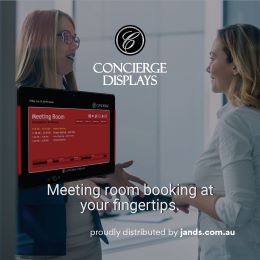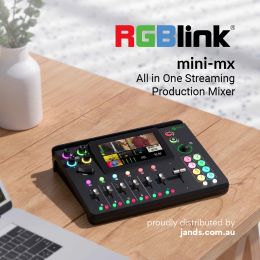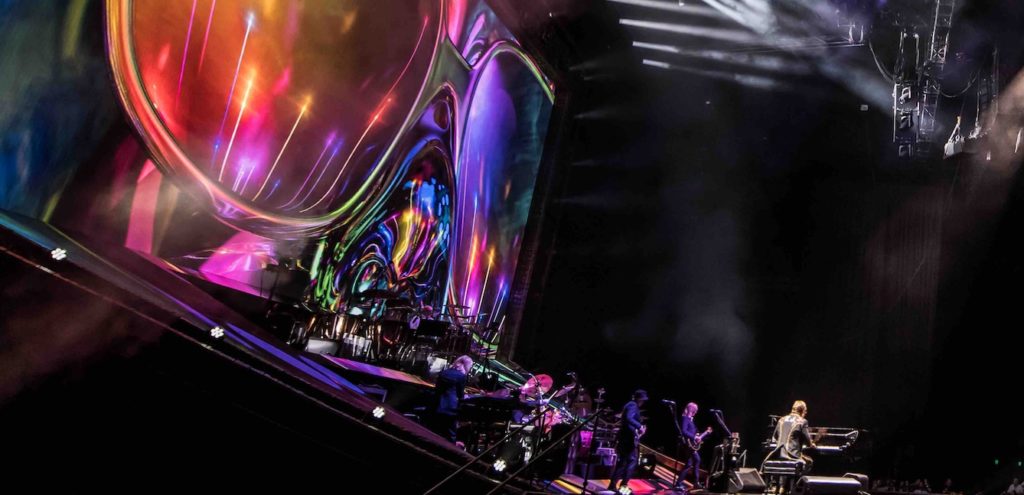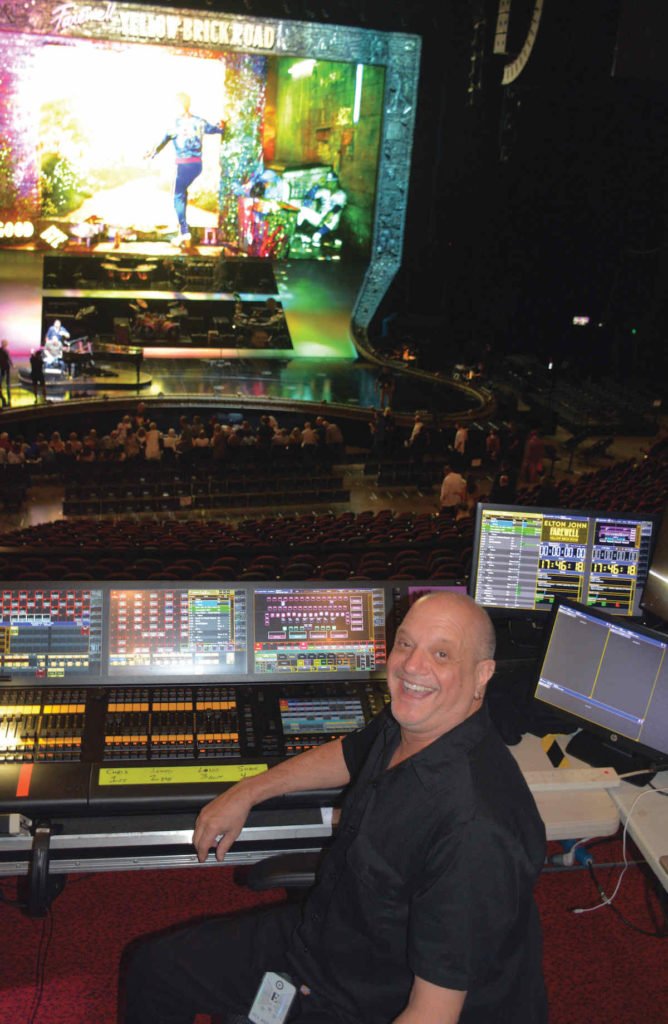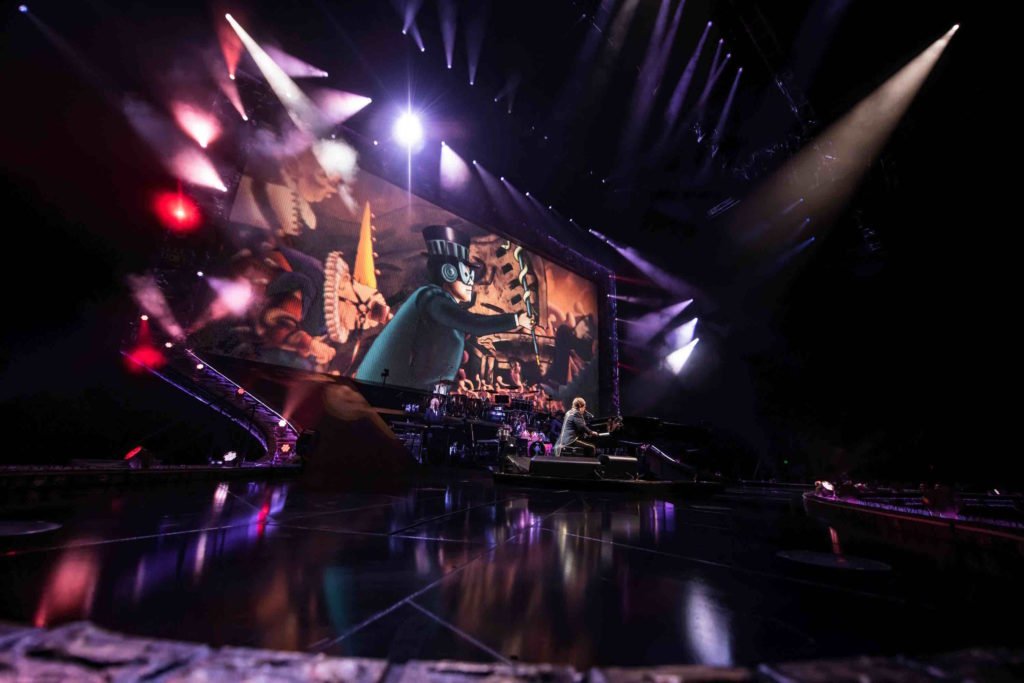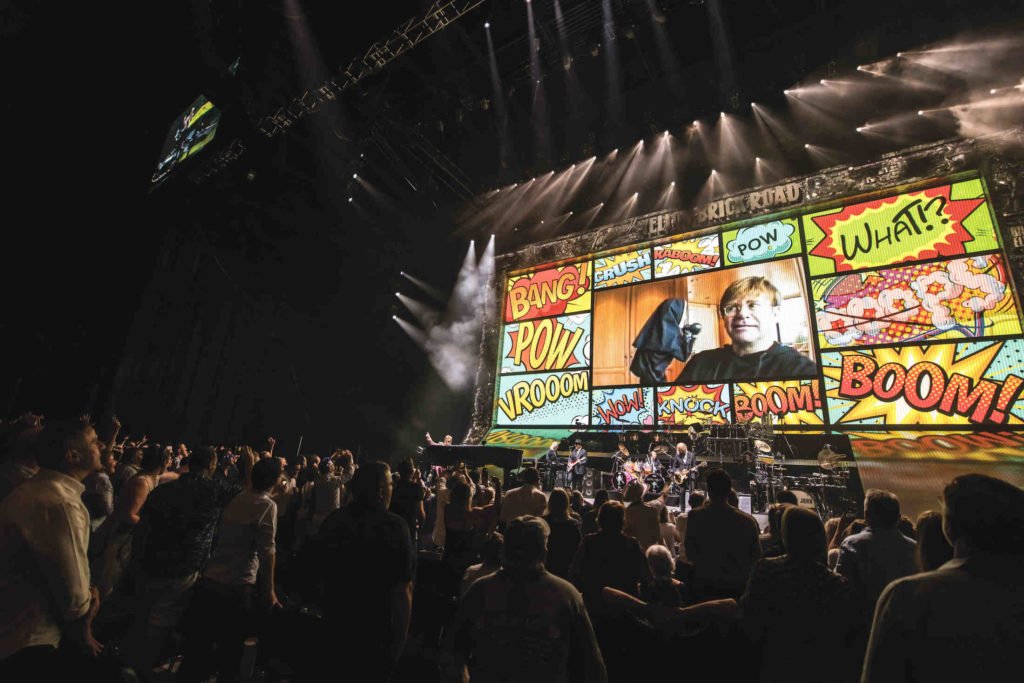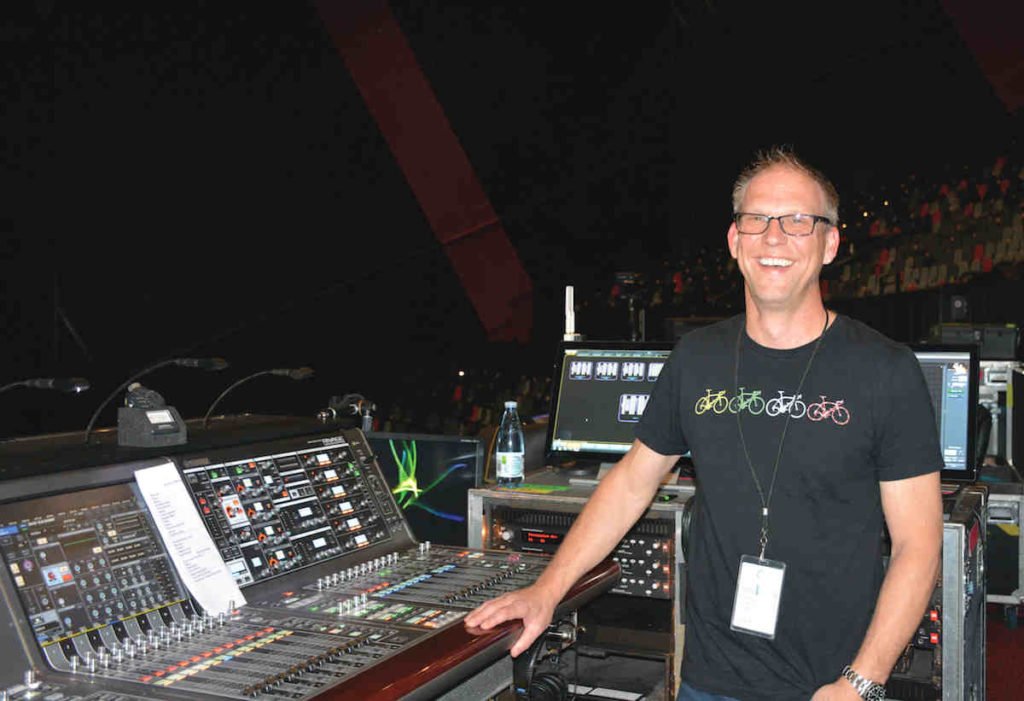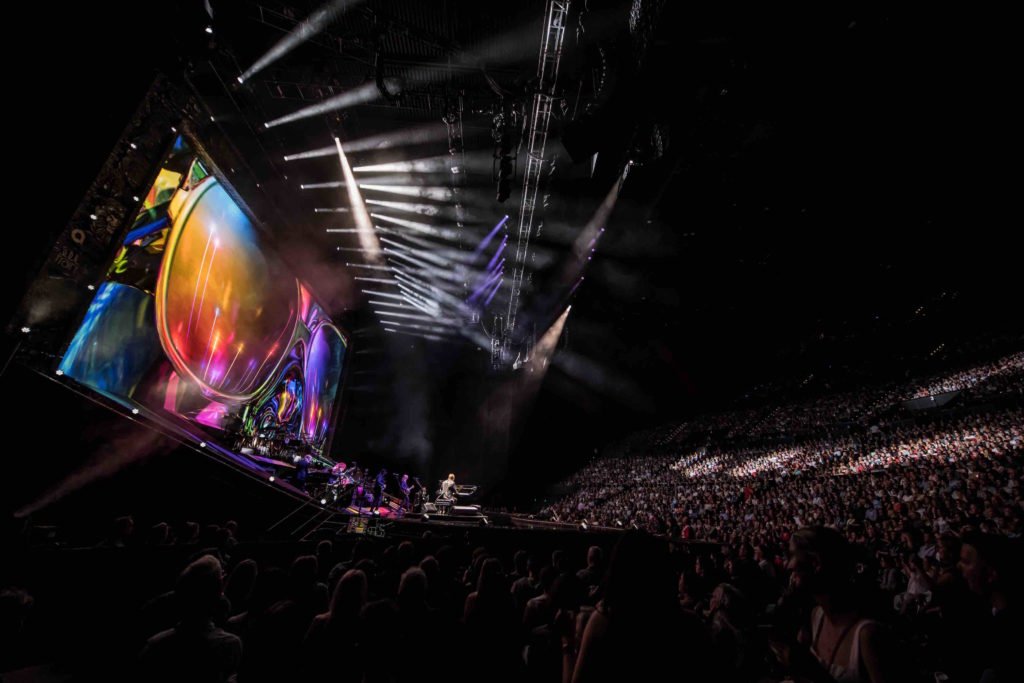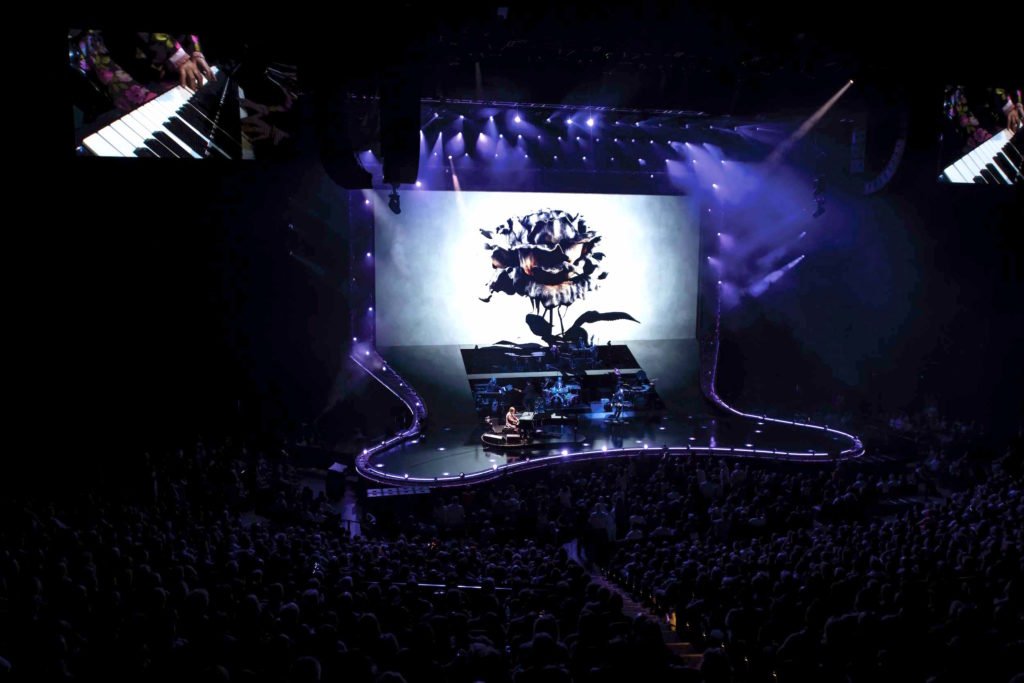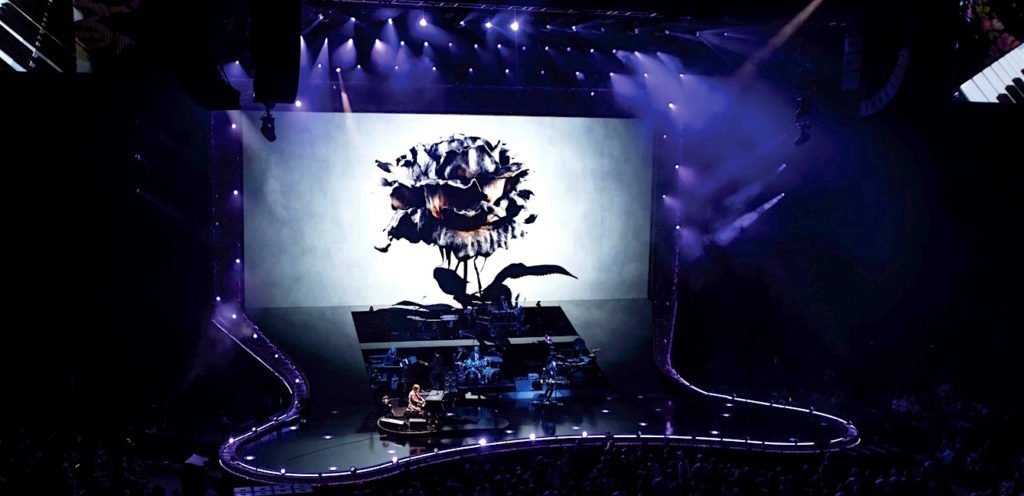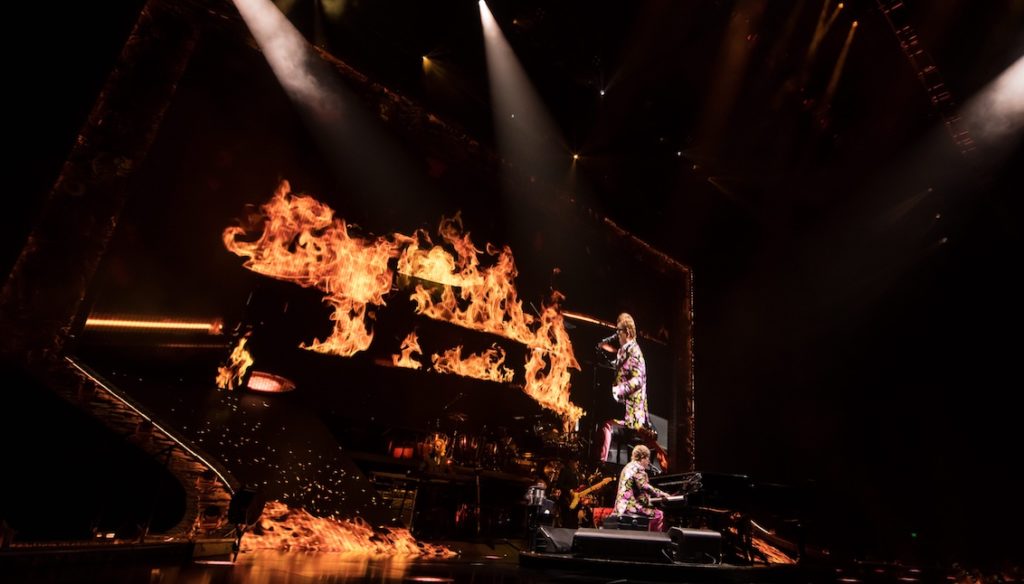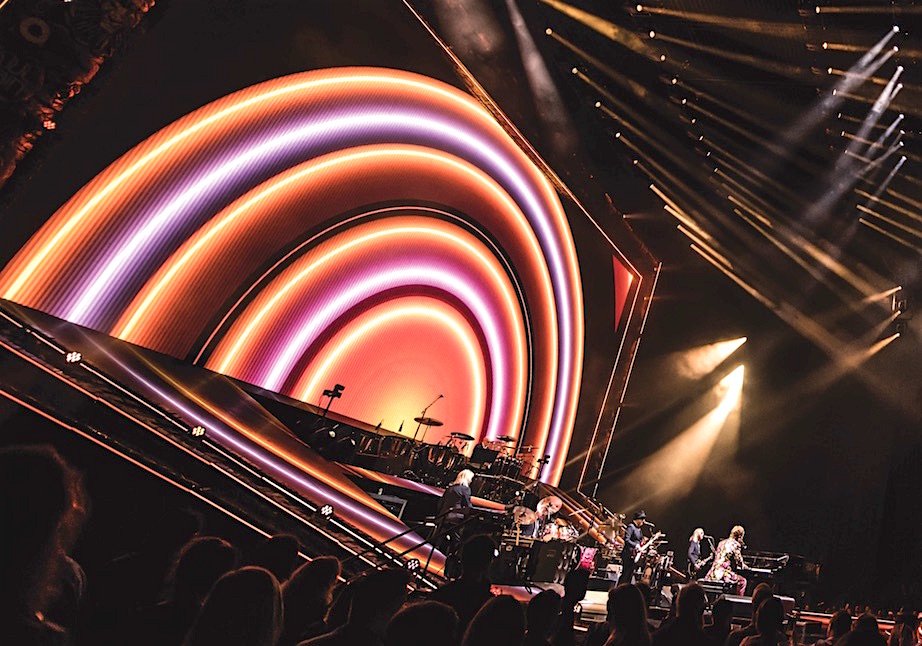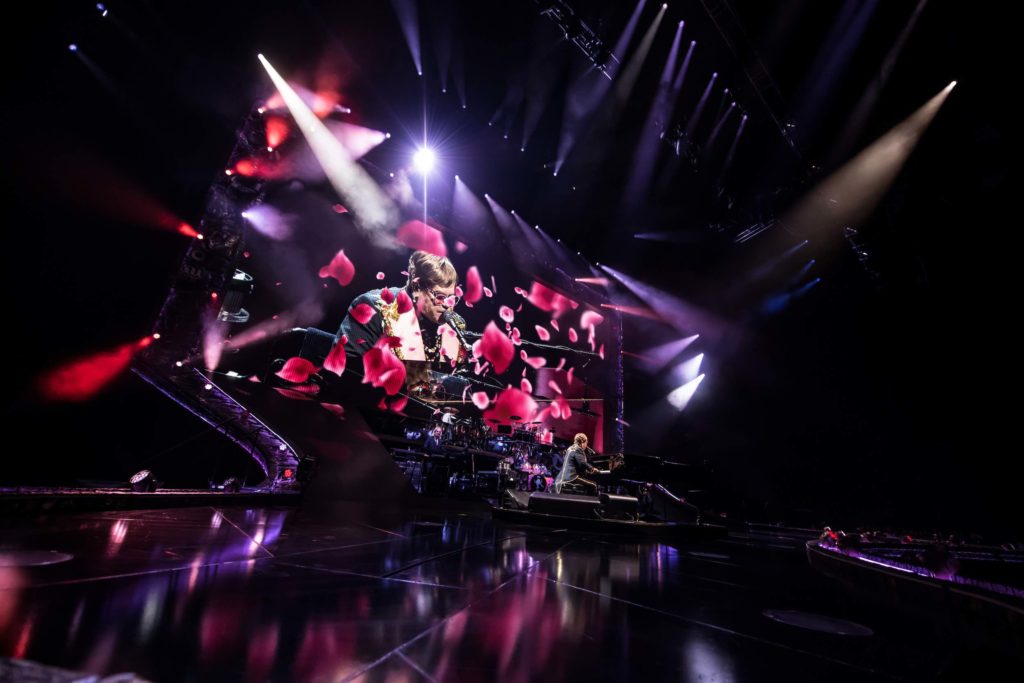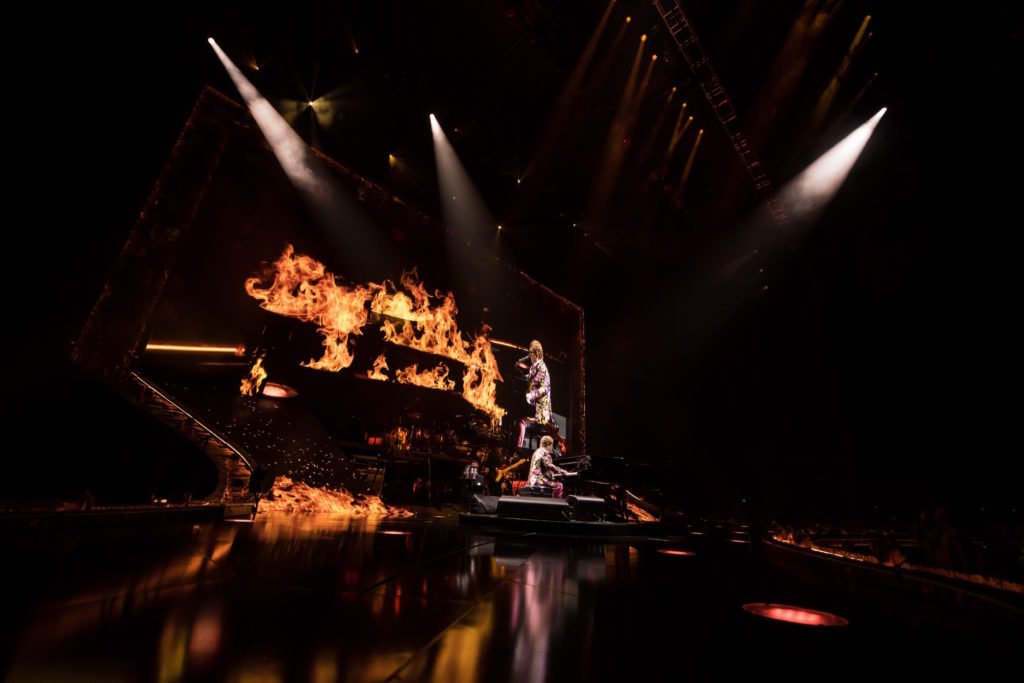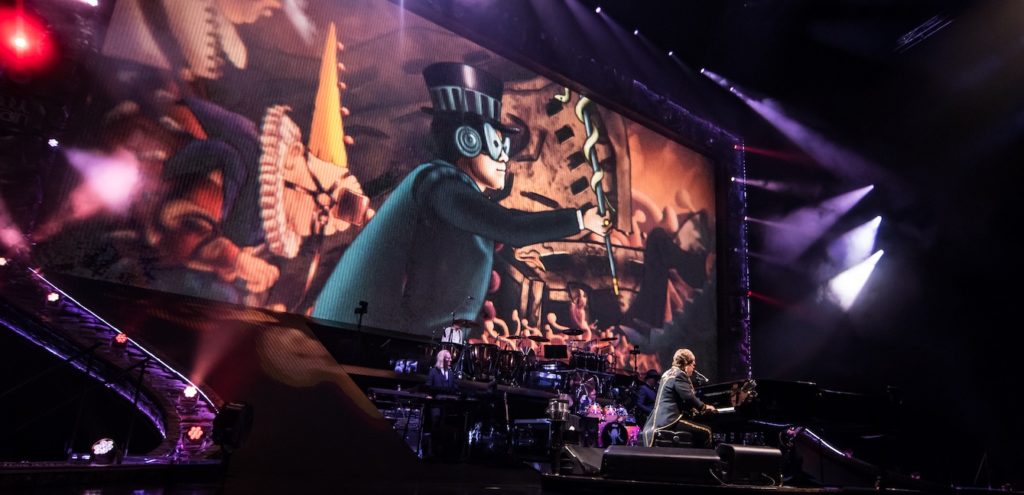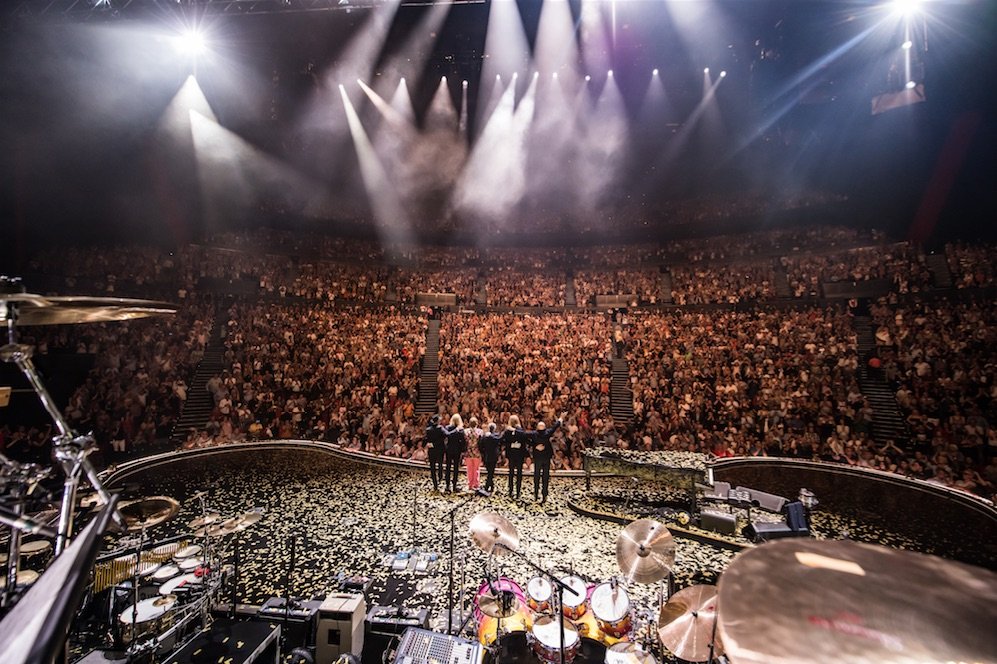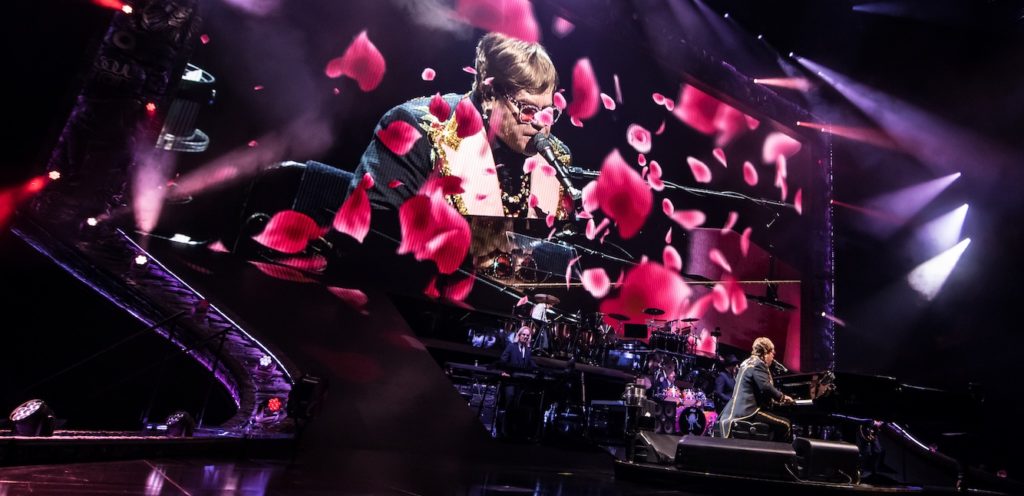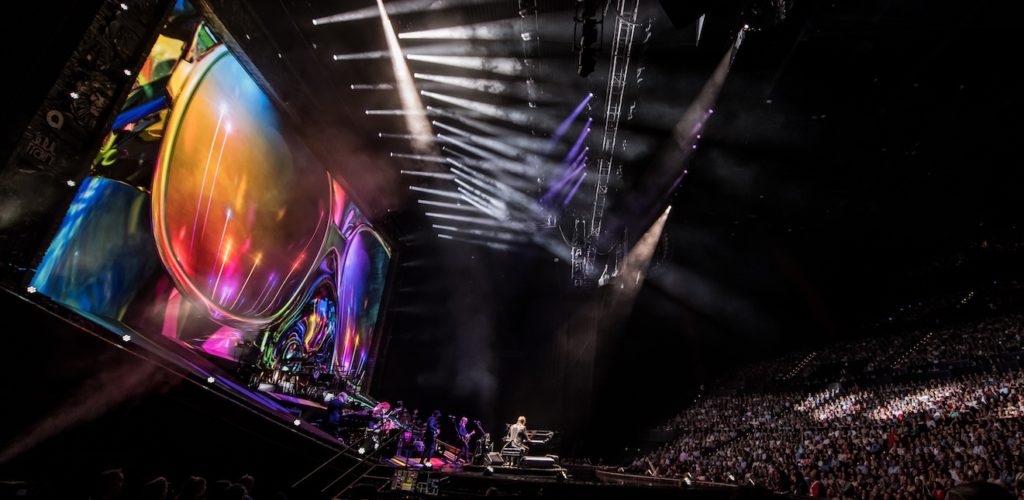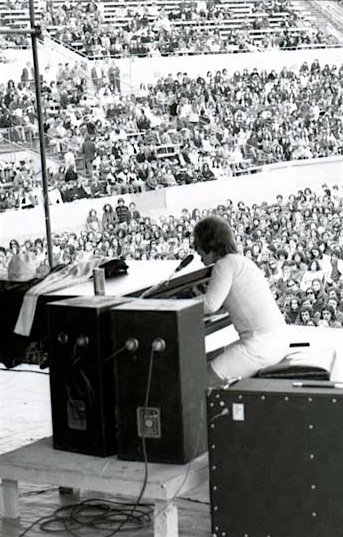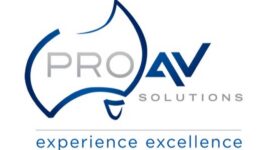Subscribe to CX E-News
Elton John
Having spent 50 years creating some of the most memorable songs in the world, it’s no surprise that Elton John’s latest show lasts close to three hours.
The Farewell Yellow Brick Road tour will wind its way around the globe for three years playing approximately 300 shows. In Australia and New Zealand alone, Elton has parked himself for three months playing to thousands of fans eager to see him for the last time.
Like so many shows these days, the stage designed by Stufish and built by Tait is dominated by a massive LED screen which is used not just for IMAG but also as a way to tell the story of Elton’s life and career.
This is wrapped by a frame fashioned with highly intricate detailed scenic elements depicting moments that have influenced Elton’s life. At the top is a pixel-chasing lightbox that spells out Farewell Yellow Brick Road whilst light fixtures and LED strips illuminate the portal during the show.
The mainstage video screen is made up of two screens. Either side of the upstage video wall and rake are IMAG screens. Below the main LED screen is a video screen ramp made from Tait double-deckers with a built-in performance space for Elton John’s band.
The mainstage video screen relies on 13 Nav Hoists to remain stationary when needed and then lifts up and down to reveal a lighting truss underneath the video screen. Six Nav Hoists move the lighting truss at various times throughout the show.
The set also features a custom-curved Tait stage equipped with a downstage piano platform that tracks right and left, and rotates via Tait Navigator automation platform.
According to lighting designer Patrick Woodroffe, matching video and lighting was key to giving each song its own distinct look, to blur the lines between these two elements so that there are times when you don’t know where one begins and the other ends.
Kevin ‘Stick’ Bye has been Elton’s Lighting Director for 20 years and says that his job is to make sure that Elton and management don’t have to think about lighting.
“Also, Patrick doesn’t have to worry that his concept is not being adhered to,” he added. “I ensure that the design team’s vision goes forward. It’s been a great ride, very challenging and it’s not done yet!”
Whilst lights are concealed within the set, above the stage are simple straight trusses and two lengthy trusses stretch out over the audience in order to light up the room.
The IMAG screens also host lights thus stretching the lighting design out horizontally.
As the set is so large, the lights trim really high which presents its own challenges. Just the building of the set in an arena is a mammoth task especially as it is not scalable.
“It has to be built the way it is,” said Stick. “You’ve got to hit your trim marks every day and I’d say that’s the biggest challenge of lighting the stage. The stage is so video-intensive the lighting needs to work around the video, you often have to match what’s going on in the video.”
Normally the lighting rig is built on one side of the room and the stage on the other, backline is then added to the stage, the rig is flown and the stage rolls into place. The whole process takes a day.
Unfortunately, this was not possible at Sydney’s First State Super Theatre at the ICC because of the layout of the venue.
“We had to assemble the lighting rig and fly it first, there were no available points for the audience trusses so we had to flatten them out and reconfigure that,” explained Stick.
“Once that was done and everything was trimmed, we came in the next day to build the stage and add backline.”
A really bright fixture was required to cut through the video and be able to add punch from the high trim height and hence 78 Claypaky Scenius Unicos were specified with Stick noting that he also likes their gobos and framing ability.
A total of 15 Claypaky Mythos are located on the flying truss upstage as well as on the band riser. “Everything in the air is Unicos,” stated Stick.
“So far, the Unicos have been very dependable and I think it helps that we tour of own. Plus the lighting crew are so good at what they do and they are maintained very well.”
PRG BestBoy HPs were out on the audience trusses, with some used for followspots with the PRG GroundControl system, and 11 PRG Icon Edge used for floor lighting. Around 38 4-Lite square DWE moles are flown for added audience lighting when required.
46 GLP impression X4s, painted gold to match the frame around the stage, are used for the scenic framing whilst 16 impression X4 Bar 20s are also onstage.
Copious amounts of ribbon LED are all over the stage as are 24 Chauvet COLORado 2 Quad Zoom.
Stick ran an MA Lighting grandMA2 console which, during the rehearsal period at Rock Lititz was programmed by Eric Marchwinski. Stick is kept on his toes controlling all of the video content, lighting, and calling the spots.
“This is not my first experience with Eric and he knows exactly how I like the board laid out,” commented Stick. “I can have it laid out to my liking with his speedy programming talent and then it’s just a matter of adding in my own custom buttons; song-specific accents that I trigger manually.
“The video programming for the media server is done on a separate MA2 by Zach Peletz. Having said that, I’m running video content and IMAG switching is also programmed into my console.
“We do have a video director calling the show, but the cameras are programmed through the MA2.”
During the show, the other grandMA2 is operated by Lars Kristiansen, the tour Media Server programmer/FOH Guru/CAD draftsman/what-would we-do-without kind of guy!
At FOH mixing audio was Matt Herr on a Yamaha PM10 Rivage. This tour was his first foray into the digital world for Elton, having previously always mixed on analogue.
“I needed two analogue consoles which weren’t an option for me on this tour,” said Matt. “It was time to switch to digital and as I had worked with smaller Yamaha consoles for other projects, I went with the PM10, which sounds fantastic.
“The layout is great, intuitive, and it’s super easy to use. I still mix in an analogue style with no snapshots. Yamaha consoles are solid and they are super reliable.”
Out front Matt also had three Bricasti M7s; one for drums, one on the vocals, and one for other instrumentation. He uses the Delay and Harmoniser on the console, which is a H3000 live emulation which delivers the sound he requires.
He’s not a big plug-in person but did utilise a Neve Portico 5043 compressor on the vocals, Yamaha Opt 2A on the bass, and Neve 773 EQ on the kit, timps, and roto toms.
Elton likes a big, full mix and it’s a totally live show with no backing tracks. Whilst the same songs are played at every gig, Elton will often play them differently which challenges Matt every night.
Getting Elton’s vocal to stand out in the mix is easy due to his amazing voice, but Matt has to battle bleed from his two Clair 12AM wedges which Elton runs very loud.
“He uses a stereo mix of two Clair 12AM wedges which just have vocal in them and two 212AM wedges for piano and instruments,” added Matt.
Fortunately, Elton’s microphone is an Audio-Technica AE6100, a close proximity mic that affords extra cancellation and a wise choice considering the volume of his monitors.
The same mic is also used for the band members’ vocal mics with the exception of drummer Nigel Olsson. Ray Cooper also has onstage monitors whilst everyone else has IEMs. Nigel mixes his own monitors on a Soundcraft GB8 and wears headphones.
The rest of the microphones are tried and tested favourites: Sennheiser E825, AKG 414s, AKG 460s, Sennheiser 609s, E604s, MD421s, Shure SM56s, SM57s, SM58s, and Beta 52.
Fitting instrumentation around other instrumentation is another daily challenge for Matt. Getting the timps to sit in the mix is tough at times, as they come in on quite a few solos.
“If it’s a guitar solo and the timps are so overwhelming when they come in, you have to let them be heard but not drown the guitar solo and that balance can be a bit jerky,” remarked Matt.
The Clair Global Cohesion PA comprised of 16 CO-12 for the main, 16 CO-12 for the side with six flown CP-218 behind the mains. Six forward-facing CP subs on the floor aside and four cardioids inside. Six CO-8 are located underneath the stage for front fill.
There’s a 270 hang that would normally hang in an arena to cover behind the video screen but that was not required at the ICC.
“The Cohesion Series has great headroom and the separation is amazing,” said Matt. “When you have a room that isn’t the best acoustically, you have a better chance with that PA than with some others. The clarity and separation really are the best.”
The Cohesion top speakers are powered by Lab.gruppen PLM 20000Q and PLM 20K44 amplifiers and a total of six Lake LM44 processors. The system runs on proprietary Clair Lake iO software for system management, along with Smaart Live V8 for time alignment.
Elton has been a Clair client for decades and whenever he has toured Australia, JPJ supplied the audio. In fact, JPJ did his first Australian tour back in 1971 when they were still Jands (check out their Facebook page for images from that tour).
JPJ’s Nick Giameos is out on the entire tour as the system engineer and he praises the Cohesion Series saying “I have worked with all the leading brands of speaker manufacturers and the Clair Cohesion series goes up, sounds great and comes down quicker than any other speaker brand.”
CX MAGAZINE – FEBRUARY 2020
LIGHTING | AUDIO | VIDEO | STAGING | INTEGRATION

ENTERTAINMENT TECHNOLOGY NEWS AND ISSUES FOR AUSTRALIA AND NEW ZEALAND
– IN PRINT AND FREE ONLINE WWW.JULIUSMEDIA.COM
© VCS Creative Publishing
More on Elton John’s Australian touring productions?
Our coverage of Elton John’s 2002 tour from Connections Magazine – PDF extract [incomplete].
In the May 2002 edition we started a history of production in Australia called ‘Days of our Lives’. Under a caption of Elton John we wrote: “Sir Elton John has a very long relationship with Australia, having first toured here in 1971. He was the first customer for Jands’ new outdoor PA system featuring Vitavox multicell horns.” Read about this tour on JPJ Audio’s archive page, inc. breakdown of equipment used – here
Subscribe
Published monthly since 1991, our famous AV industry magazine is free for download or pay for print. Subscribers also receive CX News, our free weekly email with the latest industry news and jobs.



